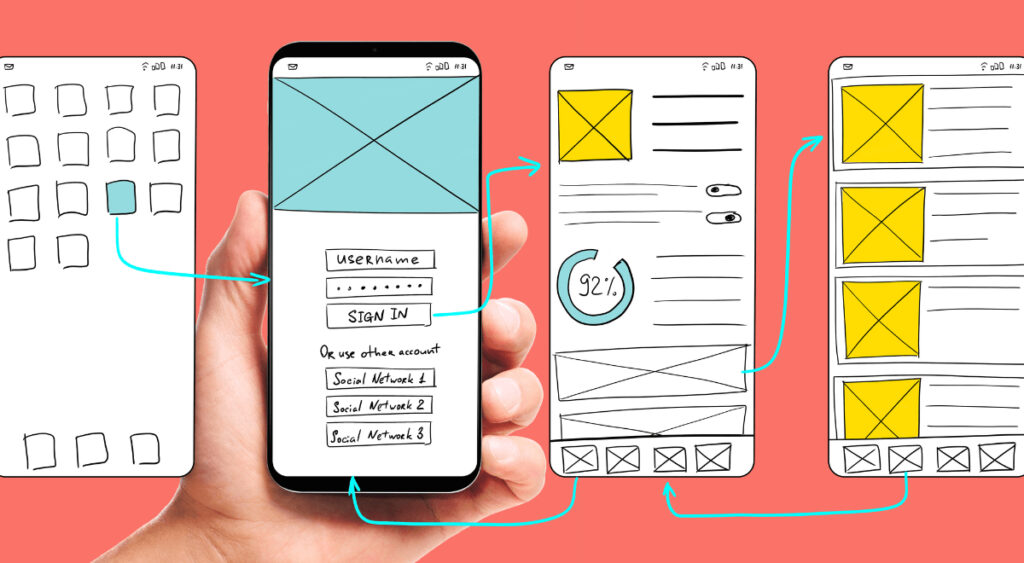- 10 step guide that will help you to create a mobile app for Android, iOS or a PWA from scratch
- Three Main Types of Mobile Apps
- Three main app development methods:
- Create an app with an app builder (no-code option)
- Step-by-Step Guide to Creating an App by app builder
- Step 1: Choose your app name
- Step 2: Select a colour scheme
- Step 3: Customise your app design
- Step 4: Choose the right test device
- Step 5: Install the app on your device
- Step 6: Add the features you want (Key Section)
- Step 7: Test, test, and test before the launch
- Step 8: Publish your app
- Step 9: Promote your app
- Step 10: Ask your users for feedback
- Conclusion
Mobile apps have transformed internet usage, providing better branding, customisation, and user interaction. E-commerce in one such industry that has benefited greatly from mobile apps, with over half of all internet traffic and online purchases coming from mobile devices. For example, 79% of smartphone users buy products online through their mobile devices, and global mobile commerce trade reaching up to 2.3 trillion by 2019.
In 2023, the landscape of mobile app trends will continue evolving, presenting opportunities and challenges for developers and users. With the emergence of new software development trends, such as AI-assisted coding, and the possible decline of older trends, like blockchain apps and low-code programming, the importance of AI and machine learning in app development will continue to grow.
Amidst massive advancements and demand for mobile applications, creating one seems rewarding but comes with complexities. This article will guide you through making a mobile app from scratch.
10 step guide that will help you to create a mobile app for Android, iOS or a PWA from scratch
Breaking down the development process can help businesses create a mobile app that caters to their requirements and those of their customers. Creating a mobile application can be complicated, so a structured and systematic approach is crucial.
Three Main Types of Mobile Apps
Mobile applications are generally of three types:

Native apps
When developers create an application, they can make a native app, which is only made for one operating system like iOS or Android. They use a specific programming language, such as Objective C for iOS or Java for Android, making them reliable and fast. Furthermore, these apps can access different phone device features like the camera and address book; some can work even without an internet connection.
Hybrid apps
A hybrid app is a phone app that works on different platforms like Android and iOS. It mixes the good parts of native and web apps. Hybrid apps use popular front-end development languages like HTML5, JavaScript, and CSS, which means they work across different platforms. This saves developers from writing different code for each platform.
Progressive web apps (PWAs)
A progressive web app (PWA) is a form of application software that is distributed via the web and developed with common web technologies like HTML, CSS, JavaScript, and WebAssembly. It is designed to function on any platform with a browser compatible with industry standards, such as desktop and mobile devices.
Three main app development methods:
Creating a mobile app is one hugely sophisticated task requiring equal app development skills and experience. But there are a few other methods, too, through which you can develop your mobile app.

Code your app yourself
Developing a mobile application yourself can be daunting, but with various app development tools and resources available, non-coders can create their own app. It’s important to clearly understand the app’s purpose, target audience, and design elements before starting. The process involves creating a wireframe, building the app with the selected tools, and thoroughly testing it.
Hire an Agency or a freelance developer
Getting an agency or freelancer to develop your mobile app is advantageous because they have the expertise, knowledge, and experience. They provide flexible pricing and excellent service. In addition, they also offer quality testing, safeguard your data, and offer continuous support to ensure your app functions smoothly.
Use an App Builder
You can use an app builder to create an app without coding skills. It offers pre-designed templates, tutorials, and drag-and-drop functions. Even people without experience in app development can create robust applications without writing any code.
Create an app with an app builder (no-code option)
No-code platforms are becoming more popular for app development because they allow people to make apps quickly without knowing how to code. Even managers and founders can use these platforms to turn their ideas into apps. However, app builder has both advantages and disadvantages to building apps through no-code platforms, which we will examine.

Pros
Reduce development time
Building no-code apps is a matter of utilising the drag-and-drop interface. Instead of tedious coding, founders and enterprises can quickly develop a functional app for release. No-code platforms also automate testing, which reduces the app’s time-to-market.
Reduce cost
Creating software used to be very expensive, even for making a simple version to test it out. But now, there are tools called “no-code platforms” that can make it much cheaper to develop an app. This means businesses and people starting a new company can save up to 80% on development costs. So they don’t need to hire expensive experts, which could be too expensive for a new business or one that’s already been around for a while.
Flexibility
No-code platforms allow people to make apps that are just as flexible and can grow as much as those made by experts who code by hand. This means that people don’t need to create a new app if they want to add more things or if more people start using it.
Easy support and update
No-code apps are easier to change than apps made by experts who code by hand. Instead of going through lots of code, people can just use pictures to make changes. People startingbusinesses or have a company can quickly change their app and launch a new version.
Cons
Platform Limitations
No-code platforms have some limitations regarding their functionalities, which can restrict what entrepreneurs and owners can do with their apps.
Low-level features not supported
If a startup or business needs to use video or audio processing functionality or accessing device sensors in their app, no-code development is not a suitable option. However, since these functionalities are typically not supported by no-code platforms, it’s impossible to create an app with these capabilities using this approach.
Platform dependent
When a startup or an enterprise builds an app on a no-code platform, they rely on a third-party technology provider. This means that factors such as pricing, service quality, and security are outside of the control of the founders or owners.
Although no-code providers can modify their pricing or terms, founders are often compelled to comply since they have few other options.
Step-by-Step Guide to Creating an App by app builder

Step 1: Choose your app name
The app development process begins by selecting an appropriate name that accurately represents the organisation. The name is crucial because it is how the company will be recognised on mobile devices, and as such, it should closely align with the organisation’s original name.
Step 2: Select a colour scheme
After selecting the app’s name, the next step is to choose a colour scheme that either complements the company’s primary colours or reflects the app’s purpose. For example, colours such as gold or dark silver may be appropriate if the app has an elegant theme.
Step 3: Customise your app design
Once you have chosen an appropriate name and colour scheme for your app, the next step is to decide on a suitable design. While you can incorporate creative ideas to make your app stand out from the competition, ensuring the design is user-friendly is essential.
Step 4: Choose the right test device
The next important step in app development is deciding whether to build a native or hybrid app. Choosing the right device to test the app on is crucial, considering the desired operating system and specifications.
Step 5: Install the app on your device
In this step, you should install the application on your own device to test it. This will give you a preview of the actual application and help you evaluate its performance. The aim is to check if the application functions properly and meets your desired standards.
Step 6: Add the features you want (Key Section)
The next step in the app development process is identifying the key features that should be included. It’s important to consider what features users expect from the app to make it as user-friendly and practical as possible. Moreover, ensuring that the app’s features align with the company’s core objectives, such as improving conversion rates or generating interest, is essential.
Step 7: Test, test, and test before the launch
Testing is essential to ensure a quality, error-free application. It’s not just a one-time activity before launching the app but should be done at every stage to eliminate unwanted elements and identify additional features. The last test before the public launch is particularly crucial and should be conducted with full attention.
Step 8: Publish your app
Once all the necessary steps have been completed, the next step is to launch the application. It is crucial to inform the target audience about the launch, as they are the ones who are expected to use the application.
Step 9: Promote your app
After the app has been launched, the next recommended step is to market it. Since mobile phones are widely used across the world, it is likely that many potential customers already have access to them. This is also a good opportunity to advertise your business and attract potential customers.
Step 10: Ask your users for feedback
Giving equal importance to the post-assessment part of the application development process is important. This allows companies to identify areas for improvement, as user feedback is a genuine way to understand the shortcomings of the business. Based on this feedback, features can be removed or upgraded to enhance the application.
Conclusion
Developing an app may appear overwhelming, but following the 10 steps mentioned above can simplify the process and guarantee a positive result. Numerous app creation tools exist today with technological advancements, making it easier for startups and companies to materialise their concepts. By utilising these tools and adhering to the steps in this guide, anyone can develop a user-friendly and functional app that correlates with their organisation’s fundamental objectives. Therefore, don’t hesitate to initiate your app development expedition today and observe the affirmative effect it can have on your enterprise.

Passionate engineer who loves talking about Machine learning and ways to improve Software development practices. CEO and Director of Software Engineering of Wolfmatrix.

